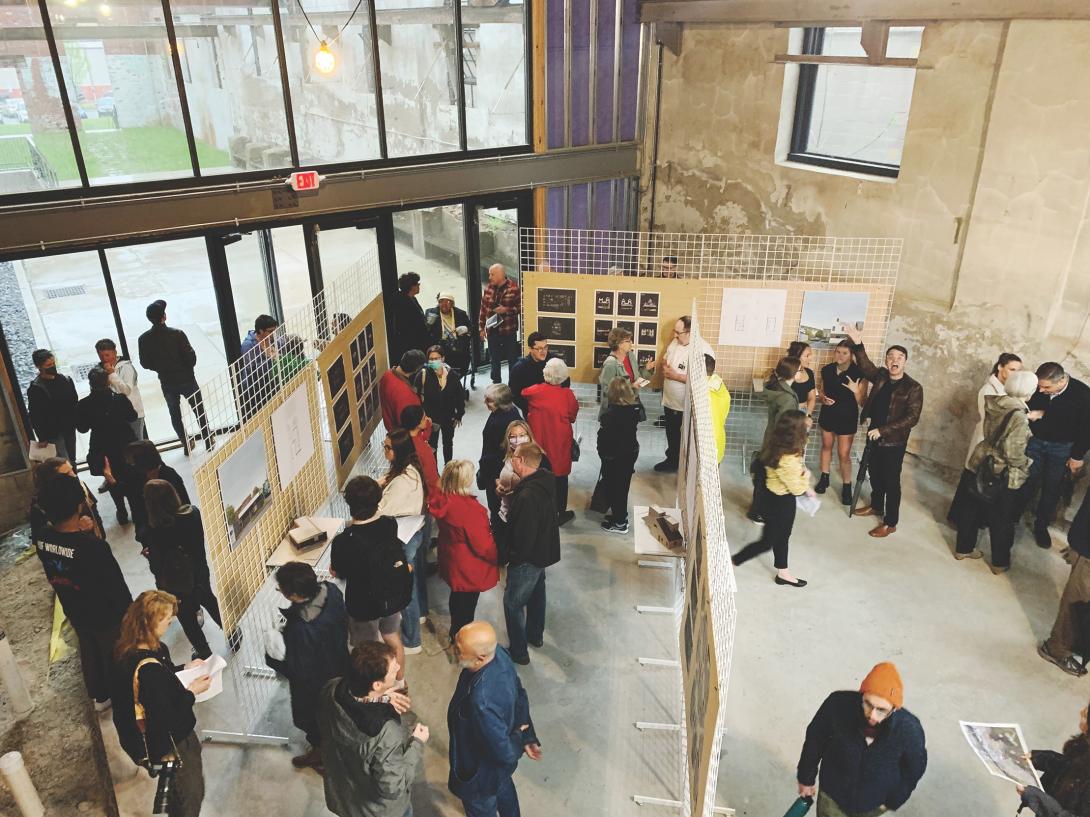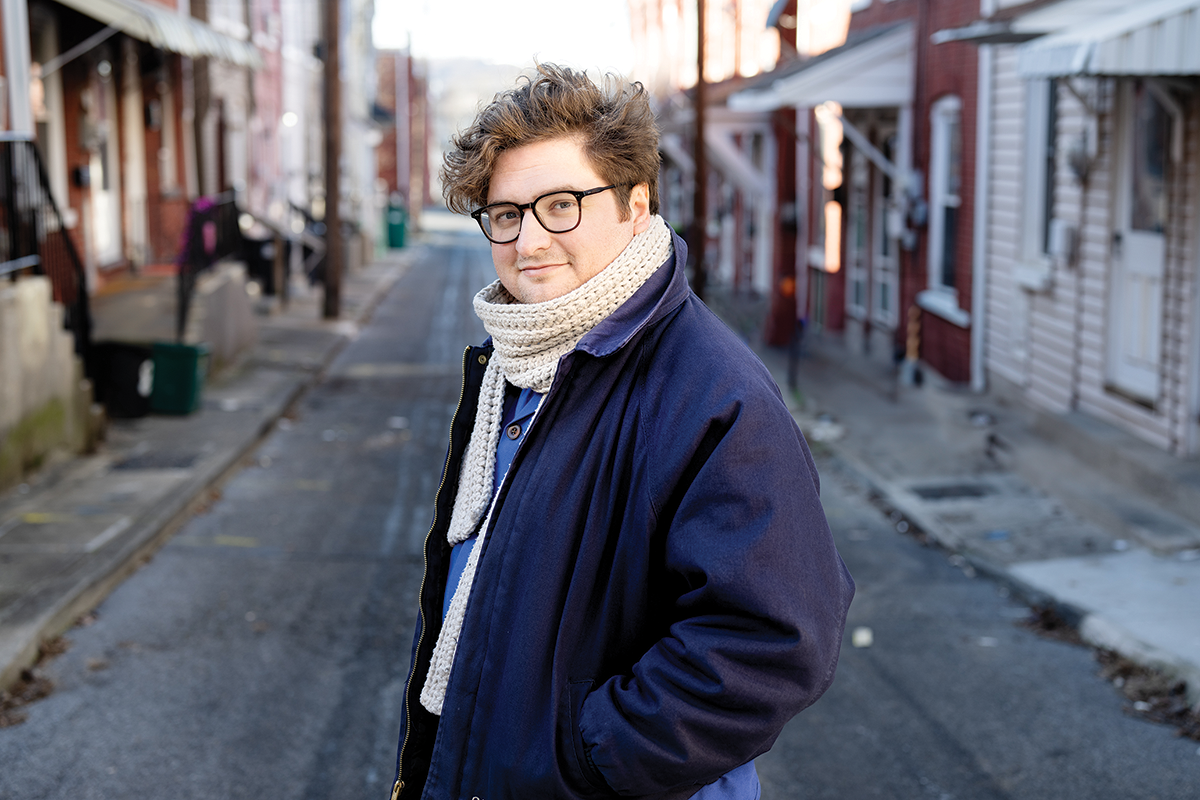Reviving Alley Houses in Bethlehem
Architect Wes Hiatt leads an effort to create affordable housing options
Wes Hiatt believes architects can use their design expertise to help inspire and manage much-needed urban change. This belief was inspired by his training. Since before coming to Lehigh, Hiatt questioned, as part of his research, how the revival of historic housing types could help resolve contemporary housing shortages. His University of Cambridge dissertation examined how architects in 1860s London helped navigate the city’s runaway change that accompanied rapid industrialization.
The assistant professor brought the philosophy of architect-as-change-agent with him when he came to Lehigh in 2021 to join the art, architecture and design department. As he settled in at the university, he began meeting with members of the Bethlehem community. A question emerged: How could the city provide more housing options for residents? Like many cities, there was an increasing demand for affordable housing and a scarcity of available dwellings. People with incomes below $50,000 were completely priced out of the market. Proposals for high-rise apartments clashed with the city’s historic structures.
“I began by acknowledging that the housing crisis in Bethlehem is a complex challenge, and there are people already working on these issues that know a whole lot more than I do. I had to start conversations and really listen to these people to begin to frame the problem,” Hiatt recalls. “If we need housing in Bethlehem, but there is a kind of general resistance to denser, five-story-plus apartment buildings that are unaffordable, what is another way to think about this that relates to the history of Bethlehem?”
Hiatt found an answer in what at first might seem an unlikely spot: the alleys of the city. His research led to a proposal suggesting that alley houses could be a solution. Alley houses are small houses built on land already occupied by a primary residence—usually in its backyard. They face alleyways instead of streets. In a city where there is little available land for building, the concept uses existing parcels.
There is a precedent in Bethlehem for this type of structure, which today would be called an accessory dwelling unit, or ADU. Historically, the city had alley houses, carriage houses and other structures that today would be considered ADUs. From the 1920s to the 1950s, zoning reform outlawed building such dwellings in many American cities. Today, Bethlehem’s zoning laws prohibit them.
Hiatt’s yearlong research into the issue culminated in Southside Survey: Housing Futures for South Bethlehem, a pop-up design and research exhibition held in May 2022 at the Brinker Lofts. The exhibit featured prototype models of alley houses in several sizes. Hiatt’s concepts included small units accommodating a single person and others large enough for a family. The ideas presented were enthusiastically received by community members in attendance.

The project was recognized by the American Institute of Architects (AIA) Eastern Pennsylvania with a 2022 Award of Excellence for sustainable design. The AIA jurors praised Hiatt’s work, saying “this project serves as a powerful response to one of our built environment’s most important sustainability issues—that of increasing urban density in the interest of economizing on land, infrastructure and, most importantly, the carbon impact of automobile-based urban sprawl.”
Now Hiatt’s proposal is moving from concept to reality under a unique partnership between Lehigh; the city of Bethlehem; New Bethany, an organizaion that offers hope and support to people who experience poverty, hunger, and homelessness; and Community Action Lehigh Valley, an anti-poverty organization that works to improve affordable housing and increase economic opportunity in the Lehigh Valley. A pilot program to build an affordable alley house in West Bethlehem is planned to start in 2024.
Hiatt says this work would not be possible without strong, collaborative community partnerships.
“In talking about managing change as an architect, my goal is to visualize what responsible urban change can look like and then coordinate all the parties involved in making that change a reality,” he states. “That’s the goal here: to be a convener and to generate ideas rather than impose change in a top-down way.”
Anna Smith, director of Community Action Development Bethlehem, notes, “It’s a pretty unique kind of partnership here with an anti-poverty organization and a university and a city.”
The idea is supported by the city’s affordable housing study, Opening Doors: Strategies To Build Housing Stability in Bethlehem, which was unveiled in fall 2023. Building such dwellings requires a change in city zoning, and the plan calls for piloting a zoning update that would allow prototypes to be built.
Sara Satullo, deputy director of community development for the city of Bethlehem, says, “The alley house partnership looks to usher in a revival of a historical housing type in our city via an innovative collaboration that can ensure the alley houses remain affordable. It’s been a wonderful opportunity for city staff to collaborate with Lehigh University faculty and Community Action Lehigh Valley staff in new ways as we seek out grant funding, problem solve and work to build out the program.”
Hiatt says that Lehigh students will play a critical role in the success of the project. Involvement in the project begins with a design-build course being offered in the spring 2024 semester.
“The idea is that seven to 10 students will be out there swinging hammers with our community partners, working on a house that they helped design."

Students’ labor on the project will be paid for through support from Lehigh’s Baker Institute for Entrepreneurship.
Smith explained that Community Action Lehigh Valley is developing a long-term plan under which it would serve as the rental agent for affordable alley houses in the future.
“We’re envisioning it most likely as a scenario where Community Action would lease the backyard for a defined time period, do the construction and manage the unit for maybe 25 to 30 years. And during that time, we would oversee who it gets rented to, and we would take care of the maintenance. We would collect the rent, and the homeowner (whose property is used) would receive a portion of rent.”
Smith added that community input will be sought while developing the plan.
“We are going to be holding a series of conversations with folks in the neighborhoods to define the details of the program and to understand what concerns or questions there might be,” she says.
Each of the partners has an integral role in the pilot project. Hiatt will design the prototypes, in collaboration with Lehigh students. CALV will manage and construct the new alley house, working with Hiatt and Lehigh students on site during the building process. The city, working with Bethlehem’s Zoning Hearing Board, will work to effect temporary zoning variances to allow the pilot alley house to be built.
Satullo says, “While we expect the first alley house to need a variance, we will simultaneously be working to update city zoning to allow for ADUs in targeted neighborhoods with a scaled-back program, which could then be expanded with success.”
How an expanded initiative would look remains to be seen, Satullo adds. It might be restricted to owner-occupied lots where individual homeowners could choose to build an alley house on their property, providing housing for aging parents—colloquially called “granny flats”—or for young adults in a family needing a place to live.
The project partners are applying for grant funding for this project and have already enjoyed landmark successes. It includes $850,000 in Community Projects Funding in the federal budget. The funding has been written into the federal appropriations bill for the Department of Housing and Urban Development (HUD) and is endorsed by U.S. Congresswoman Susan Wild and Pennsylvania Senators Bob Casey and John Fetterman. This is the first time in Lehigh University’s history that a project has been included in a federal appropriations bill. The funding has been approved by the House Transportation, Housing and Urban Development subcommittee and is continuing through the legislative process.
Lehigh, the city of Bethlehem and CALV will each receive a portion of the grant funding to support their work on various parts of the project to implement alley houses in Bethlehem. In addition to design and construction, funds will be used to revise the city’s zoning ordinance, develop a community engagement and education strategy and integrate a workforce training program into the construction process.
Hiatt stresses that, while the alley house project promises to provide new options in a way that retains the historic nature of Bethlehem’s neighborhoods, it won’t solve all the issues related to creating affordable housing.
“I have never said the goal of this project is to be the silver bullet that will solve the housing crisis,” Hiatt states. “I think that often disappoints or discourages people when they hear that. But that’s kind of how the world works. Complex problems usually don’t have a singular solution. We believe that this is an important step forward in increasing the supply of housing in a responsible, community-centered way.”

